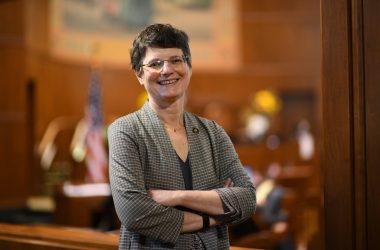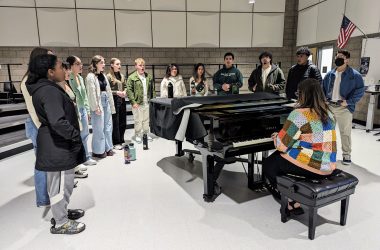
Students line up outside Highland Elementary School (Fred Joe/Special to Salem Reporter)
In spite of the effort by educators, Salem-Keizer’s high-poverty elementary schools perform on average worse than others in Oregon, even when accounting for the high number of English language learners.
The state has 195 elementary schools where more than three-quarters of students live in poverty, including 22 in Salem-Keizer. Most high-poverty Salem-Keizer schools rank in the bottom quarter of that list for the percentage of students meeting state reading standards.
About half of Oregon’s high-poverty elementary schools improved the percentage of kids meeting those standards last year. In Salem-Keizer, fewer than one in five improved.
That doesn’t mean individual students aren’t learning during their time at a school. Student scores increase between third and fifth grade at nearly every Salem-Keizer school, with marked improvements in some. But at low-performing schools, kids need to grow more from year-to-year for the school overall to show it’s doing better teaching students.
Salem-Keizer School District Superintendent Christy Perry said she thinks constantly about improving that performance. She’d like to see the district get to half of third-graders meeting state standards within a few years, at least among native English speakers. Statewide, half of elementary schoolers meet standards.
“We do a pretty good job of catching things up over time, but that elementary … is so critical. I feel the pressure and urgency of it for every kid who walks in our door as kindergarteners,” she said.
School board chair Kathy Goss, a retired teacher, said helping low-income students catch up to their peers is a top priority for the board as well.
“We have a real responsibility to pick them up where they are and move them farther,” she said.
Statewide, Oregon has set a goal of 80% of all students meeting standards by 2025.
Perry and other district officials point to the high number of students learning English in Salem-Keizer, and the district’s focus on bilingual education, as one reason for the average school’s low performance compared to peers across the state.
Across Oregon, high-poverty elementary schools where more than half of students are learning English are especially challenged. No school with those demographics has more than half its students meeting state reading or math standards.
Statewide, there are only 39 such elementary schools, mostly concentrated in a few districts.
Portland, the state’s largest school district, has none. Hillsboro has six and Reynolds, east of Portland, has seven. Salem-Keizer has 13.
Even on that list, Salem schools are concentrated toward the bottom half on student reading and math achievement.
Where other districts prioritize moving Spanish-speaking students into English instruction as quickly as possible, Perry said, Salem-Keizer has worked to grow its bilingual education programs, with a goal of developing kids who are strong readers in English and Spanish by high school.
In elementary school, bilingual classes start in kindergarten with nearly all instruction in Spanish and gradually incorporate more English as students move on. In third grade, students are still mostly reading in Spanish.

Linda Myers, Salem-Keizer School District director of academic achievement, works in her office. (Rachel Alezander/Salem Reporter)
“We have third-graders sitting in classrooms who receive their language and literacy instruction in Spanish and they take a test in English,” said Linda Myers, district director of academic achievement.
“The sacrifice you make with that is probably your third grade test scores, which isn’t your dipstick. Your end result is graduation,” she said.
Oregon does offer math and science assessments in any language spoken by more than 9% of students in the state, said Dan Farley, the state director of assessment. Currently, that’s English and Spanish.
But federal rules require the English and language arts assessment, which measures reading and writing comprehension and abilities, to be taken in English, though directions can be provided in other languages. The only exception is a one-year waiver for students who have just moved to the United States.
“The state assessment system isn’t required or geared toward students in dual language programs at present,” Farley said.
He said that while English assessment data is a good reflection of literacy in English, it may not reflect overall literacy for all students in districts like Salem-Keizer.
“There are some situations in local schools that wouldn’t match the federal assumptions,” he said.
Salem-Keizer students who were learning English before high school and moved to English-only classes by high school have a higher graduation rate than the district average, state data shows.
Bilingual educators say they’re more worried about students reading well in any language than reading well in English during elementary school.
“We’re trying to develop literacy, not test-taking,” said Kim Young, a reading teacher at Four Corners Elementary School.
That school’s assessments show 60% of dual-language second graders are reading at or above grade level when tested in Spanish. When tested in English, only one in five second-graders are on track.
That’s a dilemma for Perry. The district needs to improve its performance in elementary school, she said, and test scores at high-poverty schools still lag behind for kids who aren’t learning English.
“I want our elementary schools to be better than they are. I want us to continue to improve and I don’t want us to falsely think that just reading in Spanish is enough,” she said. But guiding kids toward fluency in two languages is a priority, and something she thinks is worth sacrificing elementary school test scores for.
“We’ll always be measured as low-performing schools in the state based on the way the state measures it,” she said. “I know our strategy is strong, but I still want our scores to get better.”

Salem-Keizer Superintendent Christy Perry. (Moriah Ratner/Special to Salem Reporter)
Bilingual education isn’t the only reason Salem-Keizer’s elementary schools have lagged behind, and Perry said she’s worked to boost results for all students since coming to the district in 2014.
Those efforts have yet to show results in elementary school, where the percentage of students meeting state standards has declined slightly in the past three years for both reading and math. Last year, 35 percent of the district’s third-graders met reading standards.
Several of Perry’s strategies weren’t fully put in place until this year.
One is a system for training students in what’s expected of them behaviorally, while tracking children who have problems and working with them in small groups or individually as needed. That’s been phased in across schools over the past three years.
The other two are academic. To hone basic reading skills, the district now has a curriculum and teaching system for kindergarten through second grade focused on the sounds letters make and phonics.
Strong teaching for reading and math are also key, Perry said. The district adopted an elementary school math curriculum this year after trying it out at several schools, and has been using a common reading curriculum for three years.
Some, though not all elementary schools that adopted the math curriculum early showed gains last year in the number of students meeting state math standards.
Perry and Goss said the largest obstacle to success is funding.
Perry’s wish list for the district’s students includes high-quality preschool for all kids, a longer school day and a longer school year, with better help for students struggling with mental health and more time for play and social-emotional learning.
All of those efforts would require more funding, like the package currently being discussed in the Oregon Legislature.
Goss has said that package won’t accomplish what it’s intended do without reforms to the state’s pension system to ensure the bulk of the funding goes toward hiring more staff, rather than paying down pension liabilities.
Having the right person in charge of a challenged school also matters.
“The district has been pretty purposeful in providing the individual leader of each of those buildings the professional latitude to make decisions based on individual settings,” Myers said.
But Perry said that too can be a challenge.
Dedicated, experienced principals sometimes are promoted to district jobs, providing their expertise across multiple schools but leaving a challenged school adapting to a new leader. One example, she said, is Olga Cobb, who was a principal at Highland, then Chávez Elementary School, before becoming one of the district’s elementary school directors
And while the proportion of Latino and Spanish-speaking students has continued to grow, curriculum and resources in schools have been slow to catch up. That influences students’ ability to learn and their teachers’ ability to assess how they’re doing in class.
When district officials bought a new reading curriculum in 2016, they were assured it would be bilingual, Cobb said. Instead, they found only some items had been translated into Spanish, making it unsuitable for teachers. Cobb worked with bilingual teachers and formed a team to adapt a Spanish version. The process took about a year.
For the past three years, Cobb said, there’s been a single screening tool across the district to test a student’s reading level in English, data used to devise more specific help for smaller groups or individuals. But there’s no corresponding system for Spanish literacy; a handful of individual schools are still trying different options.
Mindy Merritt, president of the Salem-Keizer Education Association, said the lack of comparable Spanish curriculum has been a stumbling block for teachers.
“Our curriculum within our bilingual programs is something we’re always challenged in,” she said. “We have a lot of accolades to give to our bilingual teachers, support staff and our translators. They work extra hard.”
That extra work includes additional hours to adapt or translate materials, she said.
Adding to the challenge, Salem-Keizer is seeing a growing population of students from other cultures who speak neither English nor Spanish at home, particularly Somali and Pacific Islander students, Cobb said. That means schools are seeing more students who need help beyond traditional classrooms in English or Spanish.
“We need to continue learning how to best serve them,” Cobb said.
Turnover among teachers and classroom aides is a struggle across Salem’s poorest schools, making it hard to forge connections or build on past progress.
Teachers new to the district or a school need to learn the school’s systems for assessing student progress and sometimes an entirely new curriculum. And newly graduated teachers may have a harder time responding to disruptive student behavior.
Salem-Keizer doesn’t track teacher turnover at individual schools, Myers said. Though turnover is a problem, it’s been lower on the district’s list of priorities.
Some states, including California and Washington, offer teachers extra pay for teaching at high-needs schools or encourage districts to do so. Oregon leaves the decision up to school districts, a benefit usually incorporated into a labor pact with teachers. Salem-Keizer does not have such incentives in its contracts with educators.
Adding pay incentives for teachers at high-poverty schools is a proposal that would likely come from the union, Myers said. The district might consider incentives if it were having trouble filling jobs at challenged schools, she said, but that hasn’t been the case.
Merritt said when some individual schools have offered those incentives as part of grant programs, they’ve found the extra pay doesn’t boost student performance.
“There was no real outcome as far as seeing that it made a difference,” she said. Given that, the union has never pushed for it, opting instead to advocate for higher pay for all members.
Merritt said more behavioral support and reducing class sizes would boost performance at high-poverty schools. Both would cost more money.
“We have consistent reports of room clears,” she said, referring to a practice where teachers direct students to leave the classroom because a student is throwing supplies, assaulting someone or otherwise causing a danger to themselves or others. “That interrupts our learning and that interrupts the academic success of all of those students.”
Goss said the district, under Perry, has made a clear effort to improve literacy and reading up to third grade.
She said those efforts are starting to show results, based on talking to teachers who say students are more prepared as they enter the later elementary grades.
“Considering where the kids are starting and where they’re finishing I think we’re doing pretty darn well,” she said.

This is part five of a five-part series examining the Salem-Keizer School District’s most challenged elementary schools.
Part 1: Salem schools struggle with shifting politics, challenging demographics, lagging students
Part 2: Four Corners educators fight the odds to boost student literacy
Part 3: Hallman Elementary turns federal money into student success
Part 4: With teachers staying put, Highland students make progress
Behind the scenes: How this story came about, and where we got our data.
If you have questions or comments, please email them to [email protected].
Reporter Rachel Alexander: [email protected] or 503-575-1241.
Follow Salem Reporter on FACEBOOK and on TWITTER.
Thank you for reading another example of our local journalism. This kind of work takes paid professionals and we rely on subscribers to support this work. If you haven’t yet signed on as a Salem Reporter subscriber, please ensure you get more of these kinds of stories with your subscription: Click HERE. Thank you. — Les Zaitz, editor

Rachel Alexander is Salem Reporter’s managing editor. She joined Salem Reporter when it was founded in 2018 and covers city news, education, nonprofits and a little bit of everything else. She’s been a journalist in Oregon and Washington for a decade. Outside of work, she’s a skater and board member with Salem’s Cherry City Roller Derby and can often be found with her nose buried in a book.









